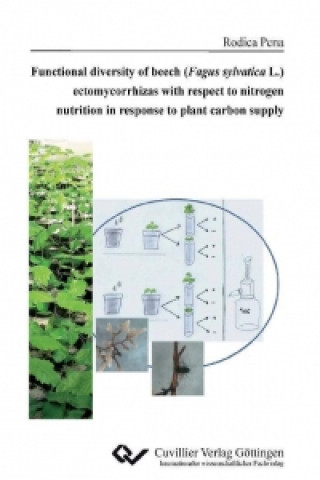
Livrare
Consilier de cumpărături





Nu se pretează? Nu contează! La noi puteți returna bunurile în 30 de zile
 Voucher cadou
orice valoare
Voucher cadou
orice valoare
Cu un voucher cadou nu veți da greș. În schimbul voucherului, destinatarul își poate alege orice din oferta noastră.
Functional diversity of beech (Fagus sylvatica L.) ectomycorrhizas with respect to nitrogen nutrition in response to plant carbon supply
 engleză
engleză
 68 b
68 b
30 de zile pentru retur bunuri
Ar putea de asemenea, să te intereseze


European beech (Fagus sylvatica L.) is the dominant tree species of the potential natural vegetation in Central Europe. In temperate forest ecosystems not affected by anthropogenic activities, nitrogen is a growth-limiting factor. Beech trees form mutualistic associations with ectomycorrhizal (EM) fungi, which have the ability to take up different inorganic and organic nitrogen-containing compounds and to improve plant nitrogen-status. EM fungal communities and functions are therefore of major interest for tree nutrition. In this work, the functional diversity of beech ectomycorrhizas with respect to nitrogen (N) and carbon (C) availability has been investigated. The following hypotheses were tested: Mobilization of litter-derived nitrogen by EM fungi differs amongst fungal species in the first phase of litter decomposition. Long-distance EM exploration types accumulate more litter-derived N than short distance ones, because of their higher accessibility to the litter. Differences in litter-derived N accumulation between EM fungal species decrease over time with the increasing availability of litter-released N via the soil. Functional differences exist between EM fungal species with respect to nitrogen uptake and processing. EM exhibit positive effects on growth, N uptake and allocation in young beech plants grown under drought conditions. These effects are reduced by long-term C limitation by shading. EM fungi influence plant capacity for N uptake by modifications in root architecture. EM fungal abundance and diversity in a mature beech stand are independent of current photo- assimilate supply and can be maintained by plant internal resources. To test these hypotheses, field experiments were set-up in an old-growth beech forest (Tuttlingen, Germany). Furthermore, either experiments were conducted with young beech plants, whose root systems were colonized by typical EM fungal communities, or which were non-mycorrhizal, exposed to light and shade, respectively, and stressed by limiting water availability. The fungal community structure was characterized by diversity indices (Species richness, Eveness and Shannon-Wiener). Morphotyping and ITS sequencing were employed for identification and quantification of EM fungi. 15N was used in the nitrogen uptake studies. The accessibility of litter-derived N for EM fungal species was investigated over a time scale of 18 months. Mesh bags filled with 15N labelled litter were exposed in the organic soil layer in a beech forest, and isotopic signatures in soil, mesh bags, fine roots and EM root tips were regularly measured. EM fungal communities were shown to be composed of species with different hyphal length and thus different abilities to directly access litter-derived N. Except Boletus pruinatus, a rhizomorphe-forming EM type, the EM fungal species, regardless their exploration type, acquired litter-derived N. In the first phase of litter decomposition, EM fungi competed for litter-derived N in their immediate vicinity and only in a later stage, they probably invaded the litterbag and obtained 15N via external mycelia. In the first phase of litter decomposition, long distance mycelia did not provide an advantage for N acquisition. To investigate functional diversity of EM fungi for uptake and processing of N, ectomycorrhizal and non-mycorrhizal young beech plants were labelled with 15N-ammonium. 15N and N contents and N turnover in the root tips colonized by different EM fungal species were determined. N turnover in the root tip varied significantly with EM fungal species. Functionality of EM fungal species, with respect to N nutrition, was diminished under drought and shade treatments. The combination of shade and drought, caused a shift of N turnover between non-mycorrhizal and EM root tips. In light, the majority EM root tips were inactive with a turnover close to zero, while in shade combined with drought, they revealed high rates of N turnover, compared with inactive non-mycorrhizal root tips. Furthermore, EM fungal species showed large differences in individual competitiveness under shade and drought stress. To address questions regarding the effects of EM on N nutrition of young beech plants, growth performance, root architecture and demography, 15N uptake and partitioning between root tips, roots, stems and leaves, total N and C concentrations in above and belowground biomass of EM and NM plants were measured. Colonization of young beech plants by EM fungi had a positive impact on N uptake. Long-term reduction of plant C productivity by shading decreased this effect. EM colonization changed the root architecture under drought conditions, by increasing the number of root tips, root surface area and root length, resulting in improved N uptake. The relationships between plant C resources and EM fungal diversity in a beech forest were investigated by manipulating carbon flux by girdling. Tree carbohydrate status, root demography and EM fungal colonization were measured repeatedly during one year after girdling. Girdling strongly affects EM fungal community. Despite of maintaining of 90% colonization rate, EM fungal species richness was reduced from about 90 to about 40 taxa. Cenococcum geophilum, Lactarius blennius, and Tomentella lapida were dominant, colonizing about 70% of the root tips, and remained unaffected by girdling. Mainly cryptic EMF species disappeared. EM diversity was positively correlated with glucose, fructose, and starch concentrations of ne roots. The above results lend supports to the concept of functional diversity of EM fungal species with respect to N nutrition, both by accessing litter-derived N and ammonium. Experiments, in which the carbon flux was modulated by girdling, shading and drought showed that current photo-assimilate supply to EM fungi play an important role in maintaining fungal effectiveness for N uptake. Moreover, in a typical beech forest, EM fungal diversity was strongly affected by reduction in belowground carbon allocation. Beech maintains numerous rare EM fungal species by recent photosynthate. These EM fungi may constitute biological insurance for adaptation to changing environmental conditions.
Informații despre carte
 engleză
engleză




 Cum să cumpăr
Cum să cumpăr




























